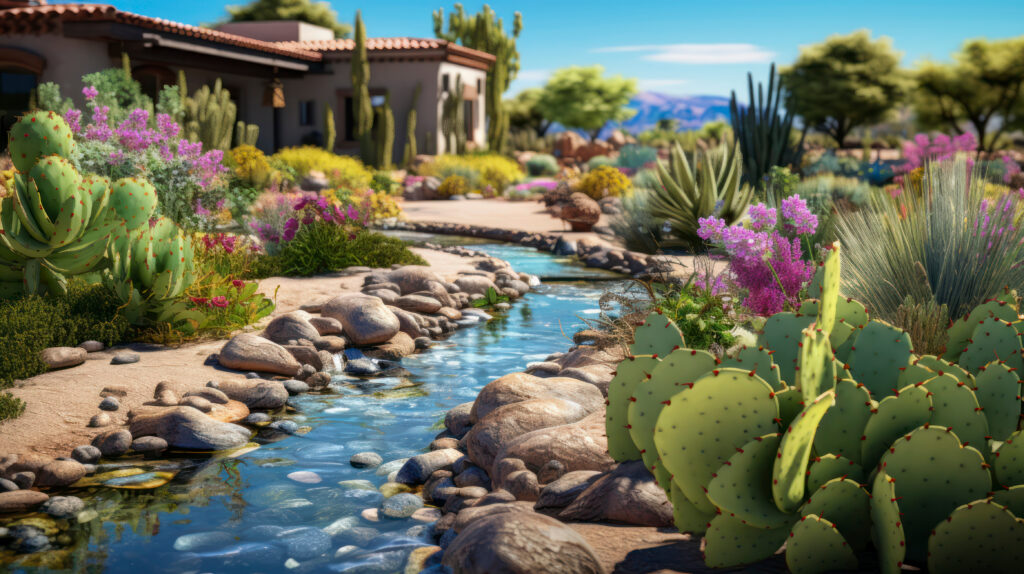Insufficient water shouldn’t mean the end to your dream of having a thriving and beautiful garden. In fact, all you need to do is careful planning. Your strategy can entail taking actions such as choosing the right plants. Through such an endeavor, you can create a stunning outdoor space. By doing this, you can be sure your landscape will be able to flourish at all times. This is even in dry conditions.
Drought-resistant gardens offer a practical solution. This is especially true in areas experiencing scarcity. They also provide a sustainable approach to landscaping. Additionally, they conserve resources without sacrificing style.
This article gives information regarding how to achieve beautiful landscapes that save water.

Let’s Save Some Water With Proper Landscape Design
Reduce Your Lawn
You need to contemplate minimizing the size of your lawn. This works quite well for individuals looking to have a drought-resistant garden. The reason behind this is that lawns are guzzlers. They require constant watering. This factor makes them quite unsustainable. This is especially true in those regions that are prone to drought.
Large turf areas can be replaced with native plants and gravel pathways. You may also consider having ground covers or decorative mulch. Going with such choices can significantly cut down on usage. This is achieved while still making sure your landscape is aesthetically pleasing.
This solution works great in helping you achieve a resilient and low-maintenance garden.
Incorporate Efficient Irrigation Systems
Insufficient water requires you to be intentional with every drop. With this in mind, you have to minimize wastage. This can be made possible by incorporating efficient irrigation systems. Incredible options to contemplate include drip irrigation and soaker hoses. These ones do a great job of delivering water directly to the roots. This goes a long way in minimizing evaporation and runoff. This is quite different when compared to traditional sprinklers.
You can take things further by integrating timers or moisture sensors. Such features make sure your plants receive just the right amount of water. This goes a long way in enhancing efficiency.
Mulch to Retain Moisture
Mulch is a great ally when it comes to drought-resistant gardening. It does well in retaining soil moisture. It also minimizes evaporation. Some great organic materials to consider using for this purpose include bark and compost. Such options provide a protective barrier against the sun and wind. They also keep the ground cooler and reduce loss.
Apart from the aforementioned, mulch helps suppress weeds. This means that there will be no competition for moisture. This is achieved while still at the same time enriching the soil as it decomposes.
In drought-prone regions, a well-mulched garden also supports healthier and more resilient plants.
Integrate Hardscaping Elements
Another way to conserve is to integrate hardscaping elements. Fantastic choices to ensure this purpose include stone pathways and gravel beds. You will also gain a lot from having retaining walls and decorative boulders. These solutions are great because they minimize the need for thirsty ground cover. They also help define garden spaces with structure and contrast.
Hardscaping entails having low-maintenance features. It also complements drought-tolerant plants. Additionally, it reduces soil erosion and improves drainage. By integrating hardscaping elements, you can be able to create a balanced and water-wise landscape. This will make sure that your outdoors look great year-round.
Smart Soil Management
The initial step to take here is to have a good understanding of the soil you have. Some popular soil types include sand and clay. Having a proper comprehension is key because some soils like sand allow water to drain fast. Others like clay tend to retain moisture. Although this is good, it may cause poor drainage and root rot.
Once you identify your soil type, you are able to make informed amendments. You can afterward take a measure like mixing in organic matter like compost. This does well in enhancing soil structure. It also boosts retention capabilities.
Water conservation has become a big issue in recent times. Due to this, drought-resistant gardens have grown in popularity. This idea has proven that it’s possible to create stunning outdoor landscapes. This is all without having to rely too much on excessive irrigation.
Some great methods that you should consider include incorporating efficient systems and doing proper smart soil management. You should also implement mulch to retain moisture and integrate hardscaping elements. Minimizing the size of your lawn can also suffice.
Through the aforementioned techniques, you can design gardens that are eco-friendly. The result will be an aesthetically pleasing and low-maintenance exterior.




